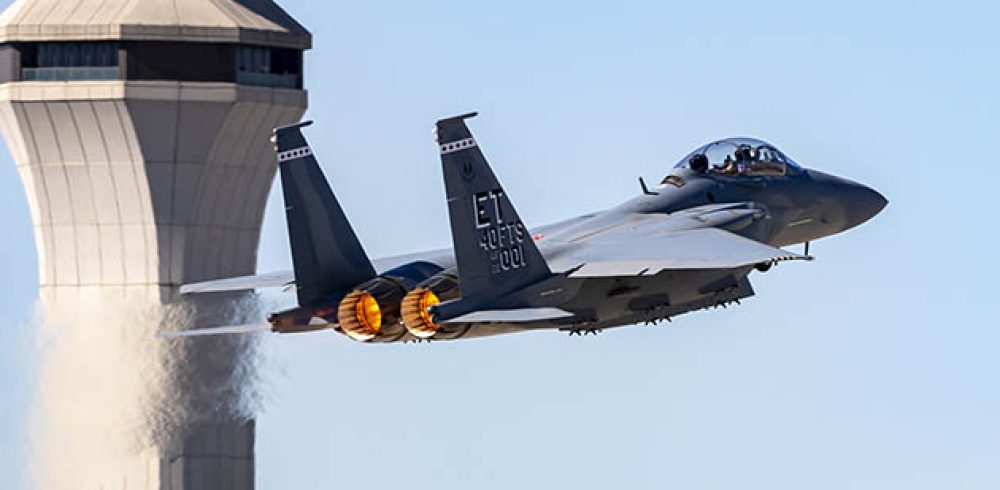Enabled by innovation and forward-thinking processes, Boeing and the U.S. Air Force formed a collaborative effort to deliver the F-15EX Eagle II. The newest version of the legendary fighter incorporates the most advanced systems available, including next-generation design and technology built on a digital thread that will ensure the U.S. Air Force will fly it for decades to come.
Incorporating the latest in software development and Open Mission Systems architecture, the F-15EX is ready today to prosecute the most demanding missions of tomorrow. To get to this point, to support customers’ needs, the Boeing team transformed its culture with initiatives such as agile innovative software, open architecture systems and digital engineering.
Agile Software
The U.S. Department of Defense has outlined a National Defense Strategy that delivers capabilities to the warfighter at the “speed of relevance.” Boeing is paving the way, producing the software at a faster pace than ever before.
Early in 2020, F-15 Mission Systems engineers began the transition to agile software development, including hardware, software integration and test. The process is part of the DevSecOps road map, an engineering practice that unifies software development (Dev), security (Sec) and operations (Ops), allowing Boeing to develop and release capabilities to the customer more efficiently and quickly.
A main driver in the transition to software development has been collaborating with the Air Force regularly during program increment planning events. The ultimate goal is to align the engineering team around developing the features and capabilities for the F-15EX platform that advance the program solution. The sessions should ultimately:
- Reduce development time to production — the average time it takes from when new software features are contracted until they are fully functional capabilities.
- Increase deployment frequency — how often a new release can be deployed into the production environment.
- Fully automate risk characterization — monitoring and mitigating challenges of software development early and often across the application life cycle.
Using this approach, the Boeing team delivered the F-15EX software in less than half the time of the typical four-year software development cadence.
Open Architecture
A key feature of the F-15EX platform is its ability to rapidly incorporate future technologies. Its open architecture will change the way the Air Force inserts future applications and capabilities and will protect warfighters by keeping them ahead of threats.
The F-15 Mission Systems software developers have created an autonomous test environment and are laying the groundwork for Open Mission Systems (OMS) architecture, which can host DevSecOps containers and orchestration — all in preparation for the future of cloud-based development. These tools also support third-party application integration — a must-have for the modern defense mission.

OMS-compliant technology also provides a standard interface between components that allows participants to develop capabilities using a common open architecture approach. By adopting this philosophy on the Eagle II, Boeing will advance and grow its legacy platform to allow rapid capability of new features in the form of containers and microservices that can be developed and deployed on the fighter jet.
Software containers package software code to allow it to run independently of any infrastructure or, in Boeing’s case, any platform. Containerization is a popular concept, gaining wide use in software development. Containers function like a smartphone app for the mission computer, as adapted by the software defense industry.
Boeing has recently demonstrated the ability to deploy the same software container on the Eagle II aircraft without any recompilation. The containerized service is the same and agnostic to the platform or mission computer hardware. The container is processed through OMS-compliant messages, a uniform construct employed by the DOD.
OMS architecture enables maximum flexibility, interoperability and connectivity. The F-15 team is employing this process as a catalyst for the culture change and development process improvements required in next-generation software development across Boeing Bombers & Fighters programs.
Digital Engineering
It is critical to continue to support model-based system engineering concepts to complete Boeing’s safety-critical functional thread analysis. This allows the enterprise to model all the safety-critical functions of the mission computer and trace them to determine safety impacts as a result of software changes to avionics equipment.
Using this methodology, Boeing engineers can investigate risks electronically, before any physical code changes, and work to understand the challenges that lie ahead and hence develop mitigation plans.
The first F-15EX fighter jet was delivered in March 2021, with the second joining it at Eglin Air Force Base, Florida, in April. The aircraft feature fly-by-wire controls, ACS, best-in-class weapons carriage, the world’s fastest mission computer, improved radar and advanced electronic warfare protection, and the newest version of the F-15 software operational flight program. Only two months after delivery, the Eagle II demonstrated its proficiency at a major Air Force exercise.
The fighter’s next-generation design makes it an ideal fit for the Air Force’s vision. For its part, Boeing is looking forward to providing a robust tactical aircraft capable of incorporating the latest advanced battle management systems, sensors and weapons.
Boeing is changing its processes and, more important, changing its culture to become more adaptive and innovative.









